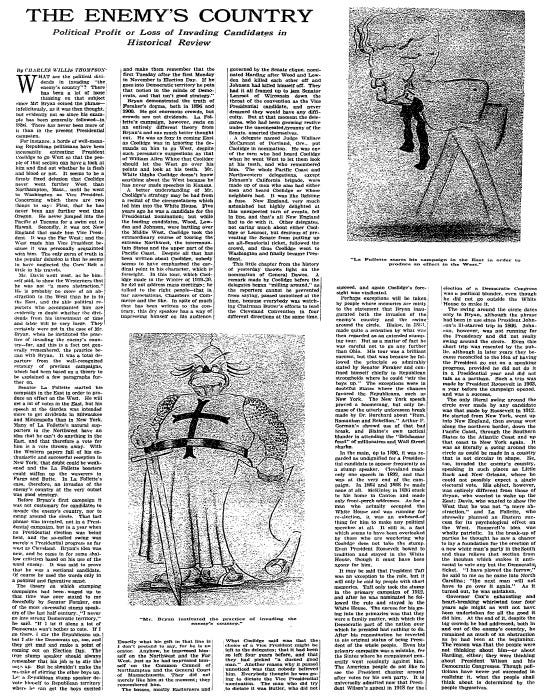The Enemy's Country: Political Profit or Loss of Invading Candidates in Historical Review
Weeks before 1924's presidential election, the challenger candidates were giving speeches around the country. But as New York Times Magazine described, incumbent Calvin Coolidge wasn't, as it was still considered beneath a president to campaign for his own reelection.
The journalist Charles Willis Thompson wrote that the Democratic Party and Progressive Party challengers, former West Virginia Rep. John W. Davis and Wisconsin Sen. Robert M. LaFollette respectively, were touring the nation.
Mr. Davis went west, as he himself said, to show the Westerners that he was not "a mere abstraction."
...
Senator LaFollette started his campaign in the East in order to produce an effect on the West... Many of LaFollette's natural supporters in the Northwest have an idea that he can't do anything in the East, and that therefore a vote for him is a vote thrown away... That doubt could be weakened and the LaFollette boosters could stiffen up the waverers in Fargo and Butte. In LaFollette's case, therefore, an invasion of the enemy's country at the very outset was good strategy.
Thompson noted that this was a relatively recent innovation in American history:
In the main, up to 1896, it was regarded as undignified for a presidential candidate to appear frequently as a stump speaker. Cleveland made only one speech in 1892, and that was at the very end of the campaign. In 1884 and 1888 he made none at all. McKinley in 1896 stuck to his home in Canton and made only front-porch addresses.
However, incumbent Republican President Calvin Coolidge was staying out of the fray.
A horde of well-meaning Republican politicians have been incessantly entreating President Coolidge to go West so that the people of that section can have a look at him and find out whether he is flesh and blood or not.
Coolidge declined to do so. According to Time Magazine's weekly roundup of the president's activities, that week Coolidge entirely stayed in Washington, D.C. (Including attending a Washington Senators versus New York Giants World Series baseball game, where he threw out the ceremonial first pitch and met Babe Ruth.)
Thompson noted that the president not campaigning for his own reelection also continued a tradition at the time:
As for a man who actually occupied the White House and was running for re-election, it was an unheard-of thing for him to make any political speeches at all. It still is, a fact which seems to have been overlooked by those who are wondering why Coolidge does not take the stump. Even President Roosevelt bowed to tradition and stayed in the White House, though it must have been agony for him.
So when did this practice change? Not too long after this article was published in 1924.
In 1936, President Franklin D. Roosevelt became the first incumbent president to give a speech at his party's national political convention, arguing for his reelection. By 1948. President Harry S. Truman delivered speeches around the country for his own reelection, traveling by train on his famous "whistle stop tour."
The Enemy's Country: Political Profit or Loss of Invading Candidates in Historical Review
Published: Sunday, October 12, 1924


